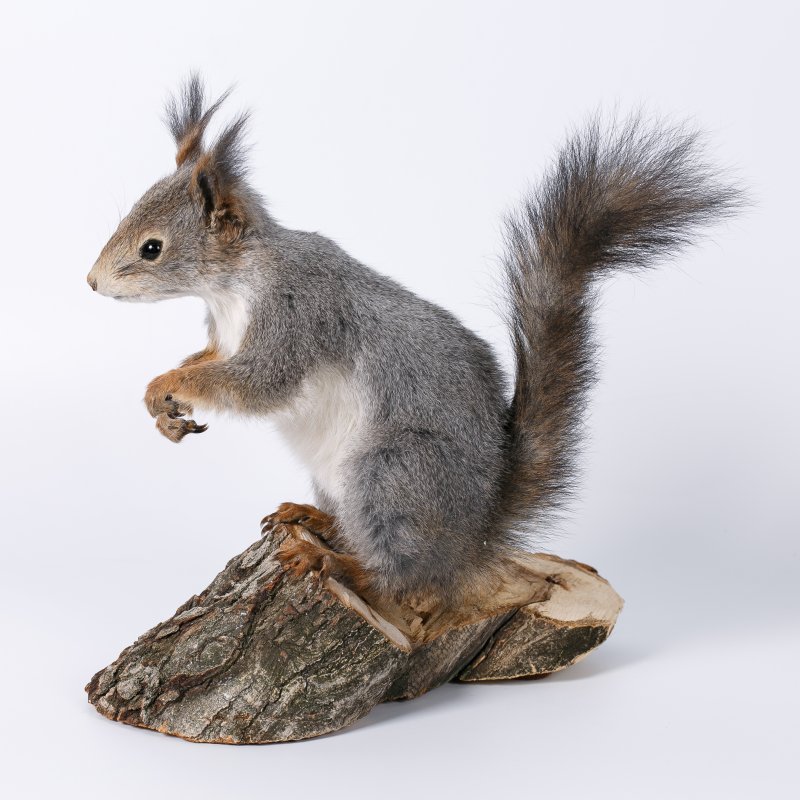10 December 2020
Welcome the new arrival - taxidermied red squirrel or Eurasian red squirrel!
(Sciurus vulgaris Linnaeus, 1758)
The Darwin Museum
collection has recently been replenished with a taxidermied red squirrel made
by the museum’s taxidermist - Valentina Kubanina.
The Red squirrel (Sciurus
vulgaris Linnaeus, 1758) is a rodent from the Sciuridae family. The only
representative of the genus Sciurus in the fauna of Russia.
The squirrel's winter
fur is long, soft, and fluffy, while summer fur is harsher, thinner, and
shorter. In terms of color variability, the squirrel holds one of the first
places among the animals of the Palaearctic. Its color changes seasonally, it
varies depending on the subspecies and even within the same population. In
summer, mainly red, brown, or dark brown tones dominate, while in winter – colors
are more often gray and black, sometimes with a brown tint. The abdomen is
light or white. There are melanistic squirrels with completely black fur and
albinos, as well as piebald squirrels, whose fur is covered with white spots.
According to the winter color of the tail, squirrels are divided into
"red-tailed", "brown-tailed" and "black-tailed".
In the steppe forests of Western Siberia, gray-tailed squirrels are found.
The size of
the squirrels decreases when moving from mountainous regions to the plains, the
size of their skull - from south to north and the color brightens towards the
center of their geographical range. Black and brown tones of winter fur in the
Carpathian, Far Eastern, and Manchurian subspecies are replaced by bluish and
ash gray.
The red squirrel is
widespread in the boreal zone of Eurasia from the Atlantic coast to Kamchatka,
Sakhalin and Japan (Hokkaido island). It was successfully acclimatized in the
Crimea, the Caucasus, and Tien Shan. More than 40 subspecies of the red squirrel
have been described, differing from each other in color.
The red squirrel lives
in all forests of the European part of Russia, Siberia, and the Far East. Around
1923-1924 it was introduced to Kamchatka, where it has become common by now.
The squirrel is a
typical forest dweller. Since its diet is based on tree seeds, it prefers mixed
coniferous-deciduous forests, which provide the best forage. It also loves
mature dark coniferous plantations - cedar forests, spruce forests, fir trees; they
like larch forests, thickets of dwarf cedar, and mixed pine forests as well. In
the north, where mainly pine and larch woodlands grow, the number of red
squirrels is low. In the Crimea and the Caucasus, it prefers gardens and
vineyards.
The lifestyle is
predominantly arboreal. It easily jumps from tree to tree, steering with its
tail. During the snowless period, as well as during the breeding season, it
spends considerable time on the ground, where it leaps up to 1 m in length. In
winter, it moves mainly among the “treetops”. In case of danger, it hides in
trees, usually in the crown. In the midst of winter, it leaves the nest only to
feed, and in severe frosts and bad weather, it can sit in the nest for a long
time, falling into a semi-drowsy state (however, it never falls into full hibernation,
unlike Spermophilus, marmots or chipmunks).
The red squirrel makes
shelters only in trees. In deciduous forests, it usually lives in hollows, making
there a soft bedding of grass, tree lichens, and dry leaves. When living in Coniferous
forests, it builds spherical nests from dry twigs, which are lined from
the inside with moss, leaves, grass, wool. The diameter of the nest is 25-30
cm. The squirrel also willingly occupies birdhouses. Males usually do not build
nests but occupy empty nests of females or blackbirds, magpies, and crows.
Large migrations of squirrels are mentioned as early as in ancient Russian chronicles. Sometimes they are caused by drought and forest fires, but more often by the shortage of the main forage - seeds of conifers and nuts. Migrations take place in late summer and early autumn. Most often, squirrels migrate not far, to the forest nearby; although sometimes they are capable of migrating long distances - up to 300 km.



Комментарии могут оставлять только зарегистрированные пользователи










